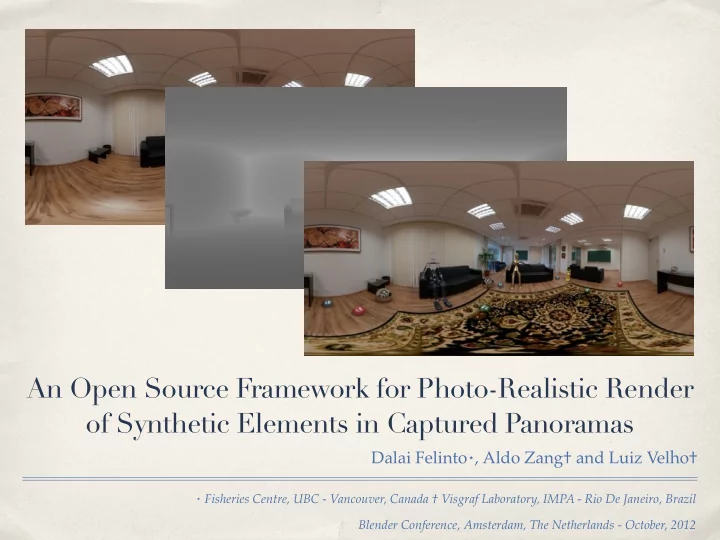

An Open Source Framework for Photo-Realistic Render of Synthetic Elements in Captured Panoramas Dalai Felinto ⋆ , Aldo Zang† and Luiz Velho† ⋆ Fisheries Centre, UBC - Vancouver, Canada † Visgraf Laboratory, IMPA - Rio De Janeiro, Brazil Blender Conference, Amsterdam, The Netherlands - October, 2012
w3.impa.br/~zang/blenderconf ?
Flight of the Navigator, 1986 The Smurfs, 2011 Terminator 2, 1991
Problems of panoramas-only solutions
So, how to make those wonderful Panoramas?
So, how to make those wonderful Panoramas? Environment capture Panorama calibration Scene reconstruction Scene depth computation Illumination setup Synthetic elements Integration and rendering
Environment capture
EV -6 EV -4 EV -2 EV 0
Calibration system
Advantages of a calibration system Allow to move important sampling regions off the poles Less concern on tripod alignment for picture capturing It works with panoramas obtained from the internet Optimal aligned axis for the world reconstruction
original panorama: hdrlabs.com
original panorama: hdrlabs.com
original panorama: hdrlabs.com
Scene Reconstruction (IBL Toolkit)
Floor Reconstruction
Panorama Background
# v e r s i o n 120 uniform sampler2D color_buffer ; uniform sampler2D depth_buffer ; uniform sampler2D texture_buffer ; uniform mat4 projectionmodelviewinverse ; # define PI 3.14159265 vec3 glUnprojectGL( vec2 coords) { float u = coords . s * 2.0, 1.0 ; float v = coords . t * 2.0, 1.0 ; vec4 view = vec4 (u , v , 1 . 0 , 1 . 0 ) ; vec4 world = projectionmodelviewinverse * vec4 (view . x , - view . y , view . z , 1 . 0 ) ; return vec3 (world [ 0 ] * world [ 3 ] , world [ 1 ] * world [ 3 ] , - world [ 2 ] * world [ 3 ] ) ; } vec2 equirectangular( vec3 vert) { float theta = asin (vert.z) ; float phi = atan (vert . x , vert . y) ; float u = 0 . 5 * (phi / PI) + 0 . 2 5 ; float v = 0 . 5 + theta / PI ; return vec2 (u , v) ; } void main( void ) { vec2 coords = gl_TexCoord [ 0 ] . st ; vec4 foreground = texture2D (color_buffer , coords) ; vec3 world = glUnprojectGL(coords) ; vec4 background = texture2D (texture_buffer , - equirectangular( normalize (world) ) ) ; float depth = texture2D (depth_buffer, coords).s ; if (depth > 0 .99995 ) foreground = background ; gl FragColor = foreground ; }
Rendering
Shadows
Reflection
Results
original panorama: blendedskies.com
original panorama: blendedskies.com
original panorama: blendedskies.com
Conclusions The Light-positional approach gives the correct world based accounts for rendering. One pass rendering solution. We don’t need to make compositions or work with layers. Extensible to Cycles render or other renderers. Light-depth map idea can be used for real time rendering in other contexts (games, interactive visualization, etc.) We can handle camera rotations and translations! It’s possible apply deformation of mesh and texture deformation to the modeled environment.
Extra 1 - Environment Texture
Extra 2 - Camera Travelling
Extra 3 - Fisheye
Acknowledgements Djalma Lucio Juliano Kestenberg Blender and Luxrender Developers Sam Schad www.blenderskies.com
Questions?
w3.impa.br/~zang/blenderconf An Open Source Framework for Photo-Realistic Render of Synthetic Elements in Captured Panoramas Dalai Felinto ⋆ , Aldo Zang† and Luiz Velho† ⋆ Fisheries Centre, UBC - Vancouver, Canada † Visgraf Laboratory, IMPA - Rio De Janeiro, Brazil Blender Conference, Amsterdam, The Netherlands - October, 2012
Recommend
More recommend